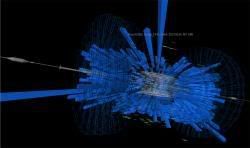Axiomatic= "obvious, fundamental or absolute." Acknowledged phenomenons in the cosmos, as well as all things relating to astronomy.
Friday, December 05, 2008
Thursday, December 04, 2008
Cool Crater Copernicus
Cool Crater Copernicus
From: marleenbryan,
19 hours ago
Facts and history of crater Copernicus
SlideShare Link
Saturday, September 27, 2008
Thursday, September 25, 2008
Friday, September 19, 2008
Thursday, September 18, 2008
Saturday, September 13, 2008
Thursday, September 11, 2008
Check Out the new Large Hadron Collider HERE
Video from NewScientist explains the LHC in detail. A MUST view!

Some of the first protons to be accelerated inside the Large Hadron Collider smashed into an absorbing device called a collimator at near light speed, producing a shower of particle debris recorded in this image. About an hour later the beam completed a full circuit of the 27km tunnel, to cheers from physicists (Image: CERN)
Sunday, September 07, 2008
M87 and it's gorgous jet
The giant elliptical galaxy Messier 87 (M87, NGC 4486), also called Virgo A, is one of the most remarkable objects in the sky.

Gorgeous detail of the Jet of M87 can be seen in this HST image which was processed by R. Mark Elowitz. The giant jet was discovered by H.D. Curtis of the Lick Observatory in 1918. This phenomenon extends thousands of light years (sources give 5,000, but maybe it is more as they are often based on too small distances of this galaxy; the present author would estimate 7-8,000 might be more likely). The jet is consisted of ejected gaseous material from the core of the galaxy. Polarimetric exposures of this jet have shown that its light is strongly polarized in a way which is typical for synchrotron radiation. It exhibits a continuous spectrum, and appears blue in (short exposure) color photos (as the one in J.D. Wray's Color Atlas of Galaxies). It is in violent turbulence; observations have shown apparent superluminal motion of gas clouds in this object - probably an illusion caused by the fact that the jet is pointing towards us.

While our Milky Way has the modest number of roughly 150 to 200 globulars, M87 possesses a remarkable system of several thousands of these objects: Moderate estimates such as the 1976 work quoted by Burnham give numbers of at least 4,000, while more modern values go up to 15,000, e.g. 13,000 in W.E. Harris' Globular Cluster Systems list), surrounding this giant galaxy in a conspicuous halo.

The telescopes at Slooh.com are able to image M87's fabulous jet as seen here in monochrome then in color images.



Gorgeous detail of the Jet of M87 can be seen in this HST image which was processed by R. Mark Elowitz. The giant jet was discovered by H.D. Curtis of the Lick Observatory in 1918. This phenomenon extends thousands of light years (sources give 5,000, but maybe it is more as they are often based on too small distances of this galaxy; the present author would estimate 7-8,000 might be more likely). The jet is consisted of ejected gaseous material from the core of the galaxy. Polarimetric exposures of this jet have shown that its light is strongly polarized in a way which is typical for synchrotron radiation. It exhibits a continuous spectrum, and appears blue in (short exposure) color photos (as the one in J.D. Wray's Color Atlas of Galaxies). It is in violent turbulence; observations have shown apparent superluminal motion of gas clouds in this object - probably an illusion caused by the fact that the jet is pointing towards us.

While our Milky Way has the modest number of roughly 150 to 200 globulars, M87 possesses a remarkable system of several thousands of these objects: Moderate estimates such as the 1976 work quoted by Burnham give numbers of at least 4,000, while more modern values go up to 15,000, e.g. 13,000 in W.E. Harris' Globular Cluster Systems list), surrounding this giant galaxy in a conspicuous halo.

The telescopes at Slooh.com are able to image M87's fabulous jet as seen here in monochrome then in color images.


Saturday, August 16, 2008
Thursday, August 14, 2008
Tuesday, August 12, 2008
Saturday, July 26, 2008
Wednesday, July 09, 2008
The Big Bang Theory!
Tuesday, July 08, 2008
Luna's best Features!
This Slideshare shows the moon's best features with some labels. Audio will be added to this sideshow in the near future! All pictures taken at Slooh.com
Monday, May 26, 2008


The first image is of the Phoenix Lander as it traverses the Martian atmosphere reading fro touchdown. The image was taken by the Mars Reconnaissance Orbiter.
Absolutely amazing what humans can do. A 422 million mile journey to an Alien World and the Phoenix Space craft survives touchdown in a perfectly healthy manner. In the next 90 days we will again be awed at the science this little fellow will produce and send back to us!!
The second image is first light from the eyes of Phoenix of the Mars Polar Region.
Sunday, May 25, 2008
Wednesday, May 21, 2008
Monday, May 12, 2008
Lunar Eclipse in Allsky Cam on March 3, 2007
Beginning of lunar eclipse the allsky cam shows a bright luna and sky. Then, during the eclipse the moon darkens as does the sky. The background stars pop out beautifully! See how the Milky Way shows up brighter during the eclipse!
Sunday, April 27, 2008
Luna on April 24, 08
Saturday, April 26, 2008
Saturn's Changing Rings!! 2005-2008
Saturn's rings change over the past three years. Over time the rings will nearly disappear to us observing from planet Earth.
Thursday, April 24, 2008
Subscribe to:
Posts (Atom)









